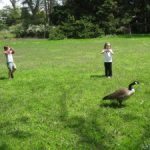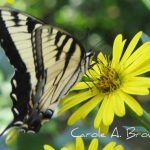Ecosystem Gardeners are in a great position to develop habitats forfrogs, toads, and other amphibians on their properties.
These habitats must include both aquatic and terrestrial environments, and provide access to food, shelter and migration corridors, plus aestivation, hibernation, breeding, and nesting sites.
Install a Garden Pond
Since most frogs and toads need water at least in some portions of their lives, the first order of business is to install a garden pond in a sunny location. Flexible or rigid liners work fine as long as there is some way for the amphibians to get in and out, such as gently sloping sides or the placement of rocks or logs to allow access.
Cover can be provided by planting native emergent plants around the pond edges. It is important to use native plants because the primary food of adult frogs and toads is insects. Native insects may not be attracted to non-native plants. Some of these plants should be species that attract night-flying moths as toads are nocturnal feeders.
Amphibians or their larvae may winter over in the pond. For this reason, it is important to allow the accumulated leaf litter to remain so that these species can burrow into it. Because garden ponds are relatively small, the installation of a pond deicer will keep a small hole in winter ice to prevent the loss of all oxygen during the colder months.
Do Not Stock Fish in Your Pond
It is important not to stock fish in the pond, either native or introduced. Fish are predators of the eggs and larva of amphibians, and also of dragonfly and damselfly larva.
It is also important to allow frogs, toads, and other amphibians to arrive at your pond site on their own (the “If you build it, they will come” philosophy). Do not stock them from other areas. Most larvae do not survive being transported to a new location.
Leave Some Areas Wild
On land, some areas should be left wild—using native flowers and shrubs to provide cover, moisture, and shade, and also allowing leaf litter to remain around the bases of these plants. Salamanders spend most of their time beneath this litter. It also provides a winter haven for overwintering toads.
Cover can also be found beneath loosely stacked rocks or logs piles as well as brush piles. Log piles may also harbor overwintering butterflies and other insects. Decaying wood is an integral element of forest communities and provides a home to many insects which supply an additional source of food for amphibians.
Do Not Use Chemicals
Most importantly, do not use pesticides, herbicides, or synthetic fertilizers. Amphibians breathe through their porous skin and are highly susceptible to these chemicals, which can cause skin lesions, disease, and death. If you leave the leaf litter in place, that will provide all of the nutrition necessary for your garden.
Help Preserve Native Wetland
Even small efforts to preserve native wetland and forest remnants can have a great impact for amphibians. When habitat conservation is combined with reductions in the use of toxic chemicals and reduction in greenhouse gases and ozone destroying emissions, this benefit can grow substantially.
To continue to help amphibians, we need to promote enforced protection of ecosystems, especially forests and wetlands, strict regulation of toxic chemicals, invasive alien species, and greenhouse and ozone-depleting gases, inventory and monitoring of amphibian populations, education on the ecological and cultural significance of amphibians, sustainable use of amphibians and their habitats, and training of herpetologists
More From Ecosystem Gardening:
Submit your review | |








